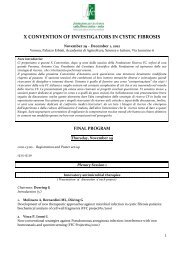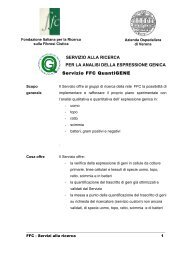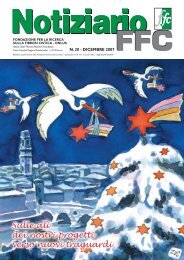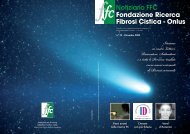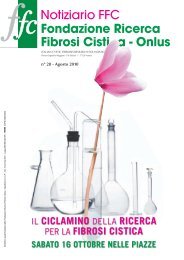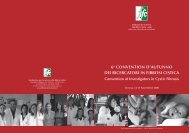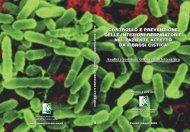Notiziario n. 25 - Fondazione Ricerca Fibrosi Cistica
Notiziario n. 25 - Fondazione Ricerca Fibrosi Cistica
Notiziario n. 25 - Fondazione Ricerca Fibrosi Cistica
Create successful ePaper yourself
Turn your PDF publications into a flip-book with our unique Google optimized e-Paper software.
tant goal to further improve the treatment of CF patients. In<br />
our project, we will consider two different targets: CFTR and<br />
the novel protein TMEM16A. For CFTR, we aim at generating<br />
1,4-dihydropyridines and aminoarylthiazoles to correct the basic<br />
defect caused by some classes of CF mutations and particularly<br />
by ∆F508, the most frequent mutation. We will also look<br />
for new chemical compounds able to stimulate the TMEM16A<br />
protein. TMEM16A is also involved in chloride transport but,<br />
differently from CFTR, it is not mutated in CF patients. Therefore,<br />
pharmacological stimulation of TMEM16A represents an<br />
alternative strategy to correct the basic defect in CF.<br />
Progetto FFC # 3/2009<br />
Dissection by RNAi-mediated silencing of molecular<br />
mechanism leading to F508del-CFTR<br />
misprocessing.<br />
Dissezione mediante silenziamento genico mediato da<br />
RNA dei meccanismi molecolari che determinano il difetto<br />
di maturazione di F508del-CFTR .<br />
Responsabile: Nicoletta Pedemonte (Laboratorio Fisiopatologia<br />
Molecolare delle Catene Ioniche – Centro<br />
Biotecnologie Avanzate – Genova)<br />
<strong>Ricerca</strong>tori coinvolti: 4. Durata: 1 anno<br />
Finanziamento: € 50.000<br />
Obiettivi:<br />
Capire come la mutazione ∆F508 arresta la maturazione<br />
di CFTR, identificando nuove proteine, bersaglio<br />
per terapie selettive.<br />
Diversi studi hanno dimostrato che esistono composti<br />
chimici in grado di ripristinare, seppur parzialmente, la<br />
funzione della proteina CFTR mutata. Tuttavia, prima<br />
di poter sviluppare nuovi farmaci occorre una migliore<br />
comprensione dei processi cellulari che determinano il<br />
destino della proteina mutata ed il suo eventuale ricupero.<br />
Il nostro progetto ha come obiettivo primario lo studio<br />
di F508del, la mutazione più frequente tra i pazienti<br />
FC. Ci proponiamo di studiare i meccanismi con i quali<br />
questa mutazione arresta la maturazione della proteina<br />
CFTR. A questo scopo ci avvarremo di una nuova tecnologia,<br />
molto potente, chiamata “interferenza genica mediata<br />
da RNA”. Con questo strumento ci sarà possibile<br />
spegnere selettivamente un gene (e la relativa proteina)<br />
per volta, valutandone gli effetti sulla maturazione della<br />
proteina CFTR mutata. Questo ci consentirà di identificare<br />
nuove proteine che costituiranno il bersaglio per<br />
trattamenti più efficaci e selettivi.<br />
Objectives: Several studies have revealed the existence of<br />
chemical compounds able to restore, at least partially, the function<br />
of mutant CFTR. However, the development of new drugs<br />
requires a better understanding of the cellular processes responsible<br />
for the fate of the mutant protein and its possible rescue.<br />
The primary objective of our project is to study F508del, the<br />
most frequent mutation among CF patients. We will investigate<br />
the mechanisms through which F508del stops the synthesis and<br />
maturation of CFTR protein. To this aim we will make use of a<br />
new, potent technology, called “RNA interference”. Using this<br />
tool we will be able to selectively silence one-by-one each gene<br />
(and the relative protein), and to evaluate the effect on the<br />
maturation of mutant CFTR protein. This will allow us to identify<br />
new proteins that will constitute the target of treatments<br />
with improved efficacy and selectivity.<br />
Progetto FFC # 4/2009<br />
Signaling potential of the ∆508-CFTR mutation:<br />
a new paradigm to explain nonchannellophaty<br />
related aspects of cystic fibrosis.<br />
La mutazione delF508 di CFTR come sorgente di segnali<br />
cellulari: un nuovo concetto per spiegare alcuni aspetti<br />
della <strong>Fibrosi</strong> <strong>Cistica</strong> (Progetto di continuazione).<br />
Responsabile: Lorenzo A. Pinna (Dipartimento Chimica<br />
Biologica – Università degli Studi di Padova)<br />
<strong>Ricerca</strong>tori coinvolti: 9. Durata: 1 anno<br />
Finanziamento: € 30.000<br />
Obiettivi:<br />
Frammenti derivati dalla distruzione della proteina<br />
CFTR mutata potrebbero spiegare aspetti della malattia<br />
non legati al difetto del canale del cloro, per<br />
escogitare nuove modalità di cura.<br />
Un enzima fondamentale presente in tutte le cellule, denominato<br />
“protein chinasi CK2”, potrebbe influenzare il<br />
destino di CFTR mutata. La proteina mutata, mediante<br />
i frammenti che si generano dalla sua intempestiva degradazione,<br />
può alterare profondamente l’attività della<br />
chinasi CK2 e quindi perturbare un gran numero di segnali<br />
e di stimoli che da questo enzima irradiano nella<br />
cellula. Questo potrebbe spiegare alcuni aspetti della<br />
FC che non dipendono dal mancato funzionamento di<br />
CFTR come canale ionico.<br />
Ci proponiamo ora di: 1) capire con quale meccanismo<br />
alcuni “peptidi” (frammenti proteici) generati dalla sola<br />
CFTR mutata (e non da quella normale) sono in grado<br />
di alterare l’attività e le proprietà di CK2 e forse anche di<br />
altri analoghi enzimi regolatori della cellula; 2) identificare<br />
quali vie di trasduzione del segnale sono perturbate in<br />
seguito all’interazione di questi peptidi con la/le chinasi;<br />
3) individuare collegamenti tra l’alterata funzionalità<br />
degli enzimi esaminati ed alcune manifestazioni della FC<br />
(per es. l’infiammazione) difficilmente spiegabili con la<br />
semplice mancanza di CFTR funzionante. Il chiarimento<br />
di questi aspetti consentirà di scoprire nuovi bersagli<br />
utili per un intervento farmacologico e di escogitare<br />
nuove modalità di trattamento della malattia.<br />
Objectives: In the course of a study aimed at disclosing the<br />
mechanism by which a fundamental enzyme, present in every<br />
kind of cells, termed “protein kinase CK2”, might affect the fate<br />
of the mutated CFTR, we came across the unanticipated observation<br />
that, the other way around, mutated CFTR, by means of<br />
its fragments generated due to its premature degradation, can<br />
ADOTTIAMO I PROGETTI DI RICERCA<br />
N. <strong>25</strong> • AGOSTO 2009 • NOTIZIARIO FFC<br />
9



